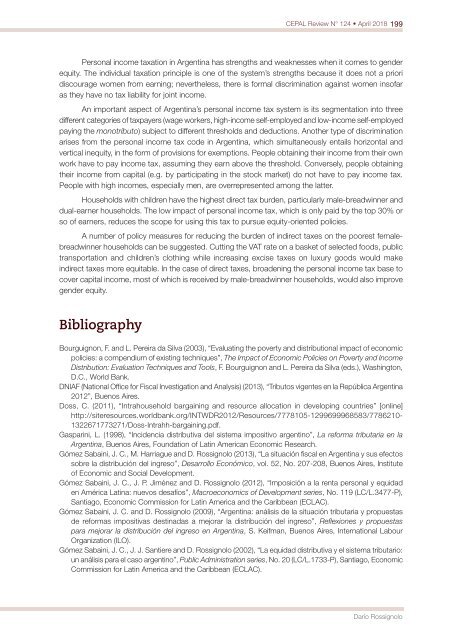CEPAL Review no. 124
April 2018
April 2018
You also want an ePaper? Increase the reach of your titles
YUMPU automatically turns print PDFs into web optimized ePapers that Google loves.
<strong>CEPAL</strong> <strong>Review</strong> N° <strong>124</strong> • April 2018 199<br />
Personal income taxation in Argentina has strengths and weaknesses when it comes to gender<br />
equity. The individual taxation principle is one of the system’s strengths because it does <strong>no</strong>t a priori<br />
discourage women from earning; nevertheless, there is formal discrimination against women insofar<br />
as they have <strong>no</strong> tax liability for joint income.<br />
An important aspect of Argentina’s personal income tax system is its segmentation into three<br />
different categories of taxpayers (wage workers, high-income self-employed and low-income self-employed<br />
paying the mo<strong>no</strong>tributo) subject to different thresholds and deductions. A<strong>no</strong>ther type of discrimination<br />
arises from the personal income tax code in Argentina, which simultaneously entails horizontal and<br />
vertical inequity, in the form of provisions for exemptions. People obtaining their income from their own<br />
work have to pay income tax, assuming they earn above the threshold. Conversely, people obtaining<br />
their income from capital (e.g. by participating in the stock market) do <strong>no</strong>t have to pay income tax.<br />
People with high incomes, especially men, are overrepresented among the latter.<br />
Households with children have the highest direct tax burden, particularly male-breadwinner and<br />
dual-earner households. The low impact of personal income tax, which is only paid by the top 30% or<br />
so of earners, reduces the scope for using this tax to pursue equity-oriented policies.<br />
A number of policy measures for reducing the burden of indirect taxes on the poorest femalebreadwinner<br />
households can be suggested. Cutting the VAT rate on a basket of selected foods, public<br />
transportation and children’s clothing while increasing excise taxes on luxury goods would make<br />
indirect taxes more equitable. In the case of direct taxes, broadening the personal income tax base to<br />
cover capital income, most of which is received by male-breadwinner households, would also improve<br />
gender equity.<br />
Bibliography<br />
Bourguig<strong>no</strong>n, F. and L. Pereira da Silva (2003), “Evaluating the poverty and distributional impact of eco<strong>no</strong>mic<br />
policies: a compendium of existing techniques”, The Impact of Eco<strong>no</strong>mic Policies on Poverty and Income<br />
Distribution: Evaluation Techniques and Tools, F. Bourguig<strong>no</strong>n and L. Pereira da Silva (eds.), Washington,<br />
D.C., World Bank.<br />
DNIAF (National Office for Fiscal Investigation and Analysis) (2013), “Tributos vigentes en la República Argentina<br />
2012”, Bue<strong>no</strong>s Aires.<br />
Doss, C. (2011), “Intrahousehold bargaining and resource allocation in developing countries” [online]<br />
http://siteresources.worldbank.org/INTWDR2012/Resources/7778105-1299699968583/7786210-<br />
1322671773271/Doss-Intrahh-bargaining.pdf.<br />
Gasparini, L. (1998), “Incidencia distributiva del sistema impositivo argenti<strong>no</strong>”, La reforma tributaria en la<br />
Argentina, Bue<strong>no</strong>s Aires, Foundation of Latin American Eco<strong>no</strong>mic Research.<br />
Gómez Sabaini, J. C., M. Harriague and D. Rossig<strong>no</strong>lo (2013), “La situación fiscal en Argentina y sus efectos<br />
sobre la distribución del ingreso”, Desarrollo Económico, vol. 52, No. 207-208, Bue<strong>no</strong>s Aires, Institute<br />
of Eco<strong>no</strong>mic and Social Development.<br />
Gómez Sabaini, J. C., J. P. Jiménez and D. Rossig<strong>no</strong>lo (2012), “Imposición a la renta personal y equidad<br />
en América Latina: nuevos desafíos”, Macroeco<strong>no</strong>mics of Development series, No. 119 (LC/L.3477-P),<br />
Santiago, Eco<strong>no</strong>mic Commission for Latin America and the Caribbean (ECLAC).<br />
Gómez Sabaini, J. C. and D. Rossig<strong>no</strong>lo (2009), “Argentina: análisis de la situación tributaria y propuestas<br />
de reformas impositivas destinadas a mejorar la distribución del ingreso”, Reflexiones y propuestas<br />
para mejorar la distribución del ingreso en Argentina, S. Keifman, Bue<strong>no</strong>s Aires, International Labour<br />
Organization (ILO).<br />
Gómez Sabaini, J. C., J. J. Santiere and D. Rossig<strong>no</strong>lo (2002), “La equidad distributiva y el sistema tributario:<br />
un análisis para el caso argenti<strong>no</strong>”, Public Administration series, No. 20 (LC/L.1733-P), Santiago, Eco<strong>no</strong>mic<br />
Commission for Latin America and the Caribbean (ECLAC).<br />
Darío Rossig<strong>no</strong>lo


















